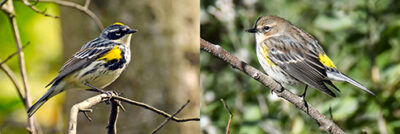
Some warblers can look so different from spring to fall, it’s hard to believe they are the same species! In spring, the songbirds we see coming through North America are stunning. Males are all bright and crisp – some with outrageously bright colors designed to attract females. But after a grueling spring migration and breeding season, a lot of songbirds are exhausted and ready for a less showy existence. So, their fall molt is one of subtle camouflage. This kind of plumage is safer for them as they are less obvious to predators, and it also requires less energy to produce. But for birdwatchers, this change into duller plumage can present challenges in identification.
Take a look at this Yellow-rumped Warbler. These birds change dramatically between seasons, but the key things to look for to make the fall ID are:
If you only see the bird from the front or underneath:
- Yellow on the sides under the wings
- Paler black striping on the white breast
- The little white crescent under the eye
If you can see the bird from above or from the rear:
- The namesake yellow rump – which never goes away!
For more ways to identify fall warblers in the field, get the Warbler Guide App which lets you do things like spin the bird around so you can see him in 3D from any angle, spring or fall filters and much more.
Yellow-rumped Warblers; Photo Credits: Deborah Rivel